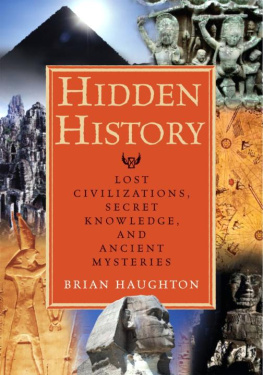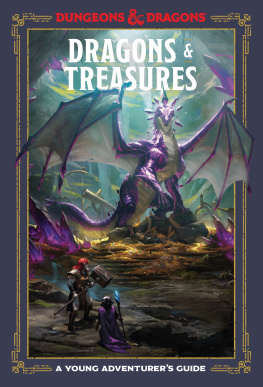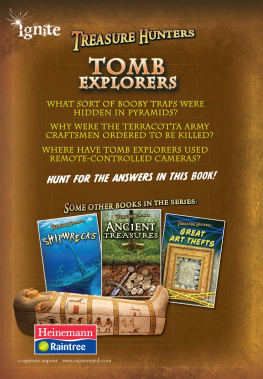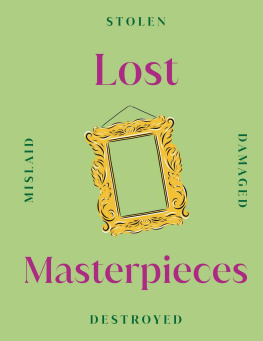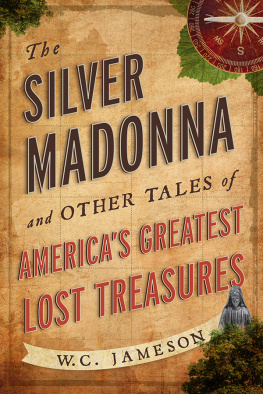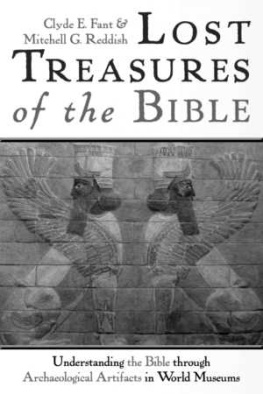Ancient Treasures
ANCIENT TREASURES
The Discovery of Lost Hoards,
Sunken Ships, Buried Vaults, and
Other Long-Forgotten Artifacts
BRIAN HAUGHTON

Copyright 2013 by Brian Haughton
All rights reserved under the Pan-American and International Copyright Conventions. This book may not be reproduced, in whole or in part, in any form or by any means electronic or mechanical, including photocopying, recording, or by any information storage and retrieval system now known or hereafter invented, without written permission from the publisher, The Career Press.
ANCIENT TREASURES
EDITED BY JODI BRANDON
TYPESET BY EILEEN MUNSON
Cover design by Joseph Sherman
Printed in the U.S.A.
To order this title, please call toll-free 1-800-CAREER-1 (NJ and Canada: 201-848-0310) to order using VISA or MasterCard, or for further information on books from Career Press.

The Career Press, Inc.
220 West Parkway, Unit 12
Pompton Plains, NJ 07444
www.careerpress.com
www.newpagebooks.com
Library of Congress Cataloging-in-Publication Data
The Library of Congress has cataloged the print edition as follows:
Haughton, Brian, 1964
Ancient treasures : the discovery of lost hoards, sunken ships, buried vaults, and other long-forgotten artifacts / by Brian Haughton.
pages cm
Includes bibliographical references and index.
ISBN 978-1-60163-249-4 -- ISBN 978-1-60163-548-8 (ebook) 1. Treasure troves--Anecdotes 2. Antiquities--Anecdotes. 3. Coin hoards--Anecdotes. 4. Hoards, Prehistoric--Anedotes. I. Title.
G525.H3226 2013
622.19--dc23
2013012532
For Marion Haughton
Acknowledgments
Thanks to my agent Lisa Hagan, of Paraview, and my family for putting up with me during the writing of this book.
CONTENTS
INTRODUCTION
Treasure can take many forms. It might be an ancient chest brimming with gold and silver objects, a romantic image of something almost mystical hidden away and forgotten in bygone times, even a legal term defined by law to denote certain types of artifacts dug up from the ground. The 1997 Treasure Act in the UK, gives a number of different types of find that qualify as treasure, including:
Any metallic object, other than a coin, provided that at least 10 per cent by weight of metal is precious metal (that is, gold or silver) and that it is at least 300 years old when found. If the object is of prehistoric date it will be Treasure provided any part of it is precious metal. All coins from the same find provided they are at least 300 years old when found. Only the following groups of coins will normally be regarded as coming from the same find: hoards that have been deliberately hiddensmaller groups of coins, such as the contents of purses, that may been dropped or lostvotive or ritual deposits.
But is the human fascination with such treasure purely a desire for wealth, or has it more to do with the romantic appeal of tales of lost ancient artifacts? It is certainly true that the stories behind the loss and recovery of a number of ancient treasures, like the Sevso Treasure and the Amber Room, for example, read like edge-of-the-seat fiction, somewhere between Indiana Jones and James Bond. But treasure need not always be in the form of gold and silver jewelry, weaponry or coins, as the chapter on the incredible cache of mummies from Deir el-Bahri, on the west bank of the Nile, opposite the city of Luxor, in Egypt, shows. The main connection between the treasures discussed in this work is that each has a story. From the riches of Tutankhamuns tomb in Egypts Valley of the Kings, to the northern European hoards of the Vikings, from ancient Chinese Treasure Ships to Nazi lootings during WWII, every treasure has a fascinating tale to tell. Such stories can shed much-needed light on the ancient cultures that originally deposited the artifacts; or, if the objects were looted from their original context, it may be the often-labyrinthine journeys of the treasures after their discovery in modern times that provide us with the astonishing narrative. In this way the ancient and the modern combine to create a unique picture of the objects that goes beyond archaeology and history.
Two chapters in this book deal with a favorite theme of treasure hunting tales: shipwrecks. The rich New World plunder of the Spanish treasure fleets of the 16th to 18th centuries has been the target of elaborate salvage attempts by modern treasure hunters, mainly off the Florida coast, whereas the remains of Admiral Zheng Hes huge Chinese treasure ships of the 15th century and their cargoes have been far more difficult to track down. The world of fake ancient artifacts is covered in another section of this work, which shows that as long as there are people rich enough and greedy enough to be fooled by appearance, often spectacularly so, as in the case of the Chiemsee Cauldron, then the trade in fake antiquities will continue to flourish.
A recurring theme in Ancient Treasures is looted treasure, and the way it more often than not finds its way to many of the worlds greatest museums, which have knowingly accepted such illegally excavated treasure hoards. There is a stark contrast between the European and North American leisure pursuit of treasure hunting, and the activities of looters in poor countries, such as some nations in Africa, Asia, Latin America, and the Middle East, which are rich in archaeological remains. (See the chapters on the Lydian Hoard and the Morgantina Treasure.) Looting is a way of life for some villagers in these areas, though they often receive as little as 1 percent of the actual value of the objects they recover, the rest going to middlemen and dealers. A countrys archaeological sites and museums are always most at risk of looting during times of war and political upheaval, and it has been estimated that between 3,000 and 7,000 objects are still missing from the Iraq Museum, which was looted in April 2003.
Archaeological looting, however, is not confined to poorer countries. In Britain, archaeological sites are still under threat from illegal metal detecting, mostly done at night by people rather romantically nicknamed nighthawks. (Thieves would be a more apt description.) A 1988 congressional report on vandalism and looting in the archaeologically rich Four Corners region of the United States (where the boundaries of New Mexico, Arizona, Utah, and Colorado meet) stated that up to 90 percent of known Native American archaeological sites in the region had been vandalized. In an article in The Arizona Republic (Stolen Artifacts Shatter Ancient Culture, November 12, 2006), Dennis Wagner reported that an estimated 80 percent of the ancient archaeological sites in the United States have been plundered. The recent phenomenon of e-trading in illicit antiquities has exacerbated the problem of looting. As Karen Olsen Bruhns says in an online article, The past is being bulldozed out of the ground and being sold on-line. Unfortunately, the fact is that as long as the demand is there (which it certainly is: The illicit market is measured in billions of dollars per year), the looting of archaeological sites and the black market for antiquities will continue.
There is often a great deal of myth and folklore surrounding treasure; indeed, some so-called treasures are probably more mythical than real (for example, the Treasure of the Knights Templar, the Ark of the Covenant, Yamashitas gold, the gold of El Dorado). It is interesting that the most common folklore theme connected with treasures is that of some type of curse or retribution for disturbing an antiquity, as if to suggest that no one should ever be allowed to get something for nothing. The infamous Curse of Tutankhamun is examined in the chapter on Tutankhamuns Treasure, but there are a number of other examples from the annals of folklore.
Next page

